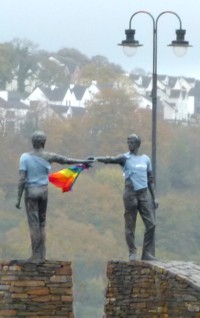The Enlightenment
Towards the end of the 17th century the world beyond Ireland was changing. Science led the way to the Enlightenment a movement that in England is normally said to have begun with the publication of Isaac Newton's Principia Mathematica (1686) and John Locke's Essay Concerning Human Understanding(1689). In France Descartes presaged Voltaire. In Scotland David Hume and Adam Smith revolutionised thinking and in America Thomas Jefferson proposed political reform that provided a rationale, beyond a naked grab for wealth and Indian land snatch by a new elite, to the American Revolution (1775-83).
David Hume and Adam Smith in Edinburgh
(David a bit chilly in winter)
Soon the stability of the old orders in Europe was shaken to its foundations by the Revolution in France (1789).
Thus the Enlightenment had come to Europe and with it a new religious scepticism and a rejection of religious extremism. Catholic emancipation began in Ireland and Britain with the 'Papists Act' of 1778, following similar reform in Quebec in Canada in 1774. Protestant extremists were appalled and protested, with riots in Scotland, but by 1793 Roman Catholics had been allowed to establish schools, attend university and, if a male land owner, to vote just like their Protestant neighbours. Thus by the time Australia was colonised by Britain in 1788 there was no legal discrimination on the grounds of religion. And in due course freedom from religious test became enshrined in the Australian Constitution in 1901.
During the 17th century the population of Ireland had been less than three million but with improved transportation, in the age of Empires, grain and fibre production was increasingly profitable. Yet agriculture was still manual and across the world land owners needed more labour. In the Americas this back breaking labour would be provided by slaves. In Russia and Ireland, land owners required their agricultural workers to reproduce. This required that they be fed, cutting into profits.
Then, in the mid-18th century, fortune, like manner from heaven, fell upon the landowners. A new food plant had been discovered in South America. It had already been cultivated and improved by the Inca in the Andes of South America over hundreds of years. And it turned out to be ideal for feeding Europe's agricultural workers - it was the potato. In less than fifty years, with the help of the potato and the Catholic Church's hunger for new souls, Ireland's peasant and predominantly Catholic population had tripled to nearly nine million and was still growing exponentially, providing plentiful cheap labour for the landowners and blossoming congregations for the Roman Catholic Church. A win-win for all concerned.

